Blind Deblurring Based on Sigmoid Function
Abstract
1. Introduction
2. Related Work
3. Methods
3.1. Image Restoration Model
| Algorithm 1 Estimate latent image |
| Input: Blurred image g, kernel estimation , regularization weight , , parameter , iterations J, K; |
| 1: , . |
| 2: while do |
| 3: if then |
| 4: for do |
| 5: Compute via (17) using , ; |
| 6: Compute via (18) using , ; |
| 7: end for |
| 8: else |
| 9: for do |
| 10: Compute via (17) using , ; |
| 11: Compute via (18) using , ; |
| 12: end for |
| 13: end if |
| 14: end while |
| Output: Intermediate latent image o. Blur kernel h. |
| Algorithm 2 Estimate Blur kernel |
| Input: Blurred image g, maximum iterations K. |
| 1: while do |
| 2: Update latent image o via Algorithm 1; |
| 3: Update blur kernel h via (18); |
| 4: end while |
| Output: Intermediate latent image o. Blur kernel h. |
3.2. Sigmoid Function
4. Experimental Results and Analysis
4.1. Performance Evaluation
4.2. Convergence Property
4.3. Compared with Traditional Methods
4.4. Compared with State-of-the-Art Methods
4.5. Effectiveness of BDA-SF
4.6. Limitation
5. Conclusions
Author Contributions
Funding
Conflicts of Interest
References
- Kwan, C.; Dao, M.; Chou, B.; Kwan, L.; Ayhan, B. Mastcam image enhancement using estimated point spread functions. In Proceedings of the 2017 IEEE 8th Annual Ubiquitous Computing, Electronics and Mobile Communication Conference (UEMCON), New York, NY, USA, 19–21 October 2017; pp. 186–191. [Google Scholar]
- Jain, A.K. Fundamentals of Digital Image Processing; Prentice Hall: Hoboken, NJ, USA, 1989. [Google Scholar]
- Pitas, I. Digital Image Processing Algorithms and Applications; John Wiley & Sons: Hoboken, NJ, USA, 2000. [Google Scholar]
- Lane, R.G. Blind deconvolution of speckle images. JOSA A 1992, 9, 1508–1514. [Google Scholar] [CrossRef]
- Yan, H.; Liu, J.; Li, D.Z.; Sun, J.D. Incremental Wiener filter and space-adaptive regularization based super-resolution image restoration. J. Electron. Inf. Technol. 2005, 27, 35–38. [Google Scholar]
- Shui, P.L. Image denoising algorithm via doubly local Wiener filtering with directional windows in wavelet domain. IEEE Signal Process. Lett. 2005, 12, 681–684. [Google Scholar] [CrossRef]
- EVANS, J. Canadian Data May Portend Steeper Rise in Diabetes Rates. Clin. Endocrinol. News 2007, 2, 6. [Google Scholar]
- Burrows, T. Nuclear data sheets for A = 50. Nucl. Data Sheets 1995, 75, 1–98. [Google Scholar] [CrossRef]
- Zhang, J.; Zhang, Q. Noniterative blind image restoration based on estimation of a significant class of point spread functions. Opt. Eng. 2007, 46, 077005. [Google Scholar] [CrossRef]
- Zhang, J.; Zhang, Q. Blind image restoration using improved APEX method with pre-denoising. In Proceedings of the Fourth International Conference on Image and Graphics (ICIG 2007), Chengdu, China, 22–24 August 2007; pp. 164–168. [Google Scholar]
- Steriti, R.; Fiddy, M. Blind deconvolution of images by use of neural networks. Opt. Lett. 1994, 19, 575–577. [Google Scholar] [CrossRef] [PubMed]
- Chakrabarti, A. A neural approach to blind motion deblurring. In Proceedings of the European Conference on Computer Vision, Amsterdam, The Netherlands, 11–14 October 2016; Springer: Berlin/Heidelberg, Germany, 2016; pp. 221–235. [Google Scholar]
- Jia, J. Mathematical Models and Practical Solvers for Uniform Motion Deblurring; Cambridge University Press: Cambridge, UK, 2014. [Google Scholar]
- Fergus, R.; Singh, B.; Hertzmann, A.; Roweis, S.T.; Freeman, W.T. Removing camera shake from a single photograph. In ACM SIGGRAPH 2006 Papers; 2006; pp. 787–794. Available online: http://people.csail.mit.edu/billf/publications/Removing_Camera_Shake.pdf (accessed on 2 April 2021).
- Xu, L.; Jia, J. Two-phase kernel estimation for robust motion deblurring. In Proceedings of the European Conference on Computer Vision, Heraklion, Greece, 5–11 September 2010; Springer: Berlin/Heidelberg, Germany, 2010; pp. 157–170. [Google Scholar]
- Cho, S.; Lee, S. Fast motion deblurring. In ACM SIGGRAPH Asia 2009 Papers; 2009; pp. 1–8. Available online: https://dl.acm.org/doi/abs/10.1145/1618452.1618491?download=true (accessed on 2 April 2021).
- Shan, Q.; Jia, J.; Agarwala, A. High-quality motion deblurring from a single image. ACM Trans. Graph. 2008, 27, 1–10. [Google Scholar]
- Levin, A.; Weiss, Y.; Durand, F.; Freeman, W.T. Understanding and evaluating blind deconvolution algorithms. In Proceedings of the 2009 IEEE Conference on Computer Vision and Pattern Recognition, Miami, FL, USA, 20–25 June 2009; pp. 1964–1971. [Google Scholar]
- Krishnan, D.; Tay, T.; Fergus, R. Blind deconvolution using a normalized sparsity measure. In Proceedings of the CVPR 2011, Colorado Springs, CO, USA, 20–25 June 2011; pp. 233–240. [Google Scholar]
- Xu, L.; Zheng, S.; Jia, J. Unnatural l0 sparse representation for natural image deblurring. In Proceedings of the IEEE Conference on Computer Vision and Pattern Recognition, Portland, OR, USA, 23–28 June 2013; pp. 1107–1114. [Google Scholar]
- Hu, Z.; Cho, S.; Wang, J.; Yang, M.H. Deblurring low-light images with light streaks. In Proceedings of the IEEE Conference on Computer Vision and Pattern Recognition, Columbus, OH, USA, 24–27 June 2014; pp. 3382–3389. [Google Scholar]
- Pan, J.; Sun, D.; Pfister, H.; Yang, M.H. Blind image deblurring using dark channel prior. In Proceedings of the IEEE Conference on Computer Vision and Pattern Recognition, Las Vegas, NV, USA, 27–30 June 2016; pp. 1628–1636. [Google Scholar]
- Pan, J.; Hu, Z.; Su, Z.; Yang, M.H. Deblurring text images via L0-regularized intensity and gradient prior. In Proceedings of the IEEE Conference on Computer Vision and Pattern Recognition, Columbus, OH, USA, 24–27 June 2014; pp. 2901–2908. [Google Scholar]
- Levin, A.; Weiss, Y.; Durand, F.; Freeman, W.T. Efficient marginal likelihood optimization in blind deconvolution. In Proceedings of the CVPR 2011, Colorado Springs, CO, USA, 20–25 June 2011; pp. 2657–2664. [Google Scholar]
- Pan, J.; Sun, D.; Pfister, H.; Yang, M.H. Deblurring images via dark channel prior. IEEE Trans. Pattern Anal. Mach. Intell. 2017, 40, 2315–2328. [Google Scholar] [CrossRef]
- Cai, J.F.; Ji, H.; Liu, C.; Shen, Z. Framelet-based blind motion deblurring from a single image. IEEE Trans. Image Process. 2011, 21, 562–572. [Google Scholar] [PubMed]
- Yan, Y.; Ren, W.; Guo, Y.; Wang, R.; Cao, X. Image deblurring via extreme channels prior. In Proceedings of the IEEE Conference on Computer Vision and Pattern Recognition, Honolulu, HI, USA, 21–26 July 2017; pp. 4003–4011. [Google Scholar]
- Li, L.; Pan, J.; Lai, W.S.; Gao, C.; Sang, N.; Yang, M.H. Learning a discriminative prior for blind image deblurring. In Proceedings of the IEEE Conference on Computer Vision and Pattern Recognition, Salt Lake City, UT, USA, 18–22 June 2018; pp. 6616–6625. [Google Scholar]
- Cho, T.S.; Paris, S.; Horn, B.K.; Freeman, W.T. Blur kernel estimation using the radon transform. In Proceedings of the CVPR 2011, Colorado Springs, CO, USA, 20–25 June 2011; pp. 241–248. [Google Scholar]
- Whyte, O.; Sivic, J.; Zisserman, A.; Ponce, J. Non-uniform deblurring for shaken images. Int. J. Comput. Vis. 2012, 98, 168–186. [Google Scholar] [CrossRef]
- Jin, M.; Roth, S.; Favaro, P. Normalized blind deconvolution. In Proceedings of the European Conference on Computer Vision (ECCV), Munich, Germany, 8–14 September 2018; pp. 668–684. [Google Scholar]
- Bai, Y.; Cheung, G.; Liu, X.; Gao, W. Graph-based blind image deblurring from a single photograph. IEEE Trans. Image Process. 2018, 28, 1404–1418. [Google Scholar] [CrossRef] [PubMed]
- Wang, Y.; Yang, J.; Yin, W.; Zhang, Y. A new alternating minimization algorithm for total variation image reconstruction. SIAM J. Imaging Sci. 2008, 1, 248–272. [Google Scholar] [CrossRef]
- Krishnan, D.; Fergus, R. Fast image deconvolution using hyper-Laplacian priors. Adv. Neural Inf. Process. Syst. 2009, 22, 1033–1041. [Google Scholar]
- Zoran, D.; Weiss, Y. From learning models of natural image patches to whole image restoration. In Proceedings of the 2011 International Conference on Computer Vision, Barcelona, Spain, 6–13 November 2011; pp. 479–486. [Google Scholar]
- Dong, W.; Zhang, L.; Shi, G.; Li, X. Nonlocally centralized sparse representation for image restoration. IEEE Trans. Image Process. 2012, 22, 1620–1630. [Google Scholar] [CrossRef] [PubMed]
- Guo, Y.; Ma, H. Image blind deblurring using an adaptive patch prior. Tsinghua Sci. Technol. 2018, 24, 238–248. [Google Scholar] [CrossRef]
- Li, L.; Pan, J.; Lai, W.S.; Gao, C.; Sang, N.; Yang, M.H. Blind image deblurring via deep discriminative priors. Int. J. Comput. Vis. 2019, 127, 1025–1043. [Google Scholar] [CrossRef]
- Ma, L.; Xu, L.; Zeng, T. Low rank prior and total variation regularization for image deblurring. J. Sci. Comput. 2017, 70, 1336–1357. [Google Scholar] [CrossRef]
- Tang, Y.; Xue, Y.; Chen, Y.; Zhou, L. Blind deblurring with sparse representation via external patch priors. Digit. Signal Process. 2018, 78, 322–331. [Google Scholar] [CrossRef]
- Money, J.H.; Kang, S.H. Total variation minimizing blind deconvolution with shock filter reference. Image Vis. Comput. 2008, 26, 302–314. [Google Scholar] [CrossRef]
- Dong, J.; Pan, J.; Su, Z. Blur kernel estimation via salient edges and low rank prior for blind image deblurring. Signal Process. Image Commun. 2017, 58, 134–145. [Google Scholar] [CrossRef]
- Sun, J.; Cao, W.; Xu, Z.; Ponce, J. Learning a convolutional neural network for non-uniform motion blur removal. In Proceedings of the IEEE Conference on Computer Vision and Pattern Recognition, Boston, MA, USA, 7–12 June 2015; pp. 769–777. [Google Scholar]
- Zhang, J.; Pan, J.; Ren, J.; Song, Y.; Bao, L.; Lau, R.W.; Yang, M.H. Dynamic scene deblurring using spatially variant recurrent neural networks. In Proceedings of the IEEE Conference on Computer Vision and Pattern Recognition, Salt Lake City, UT, USA, 18–22 June 2018; pp. 2521–2529. [Google Scholar]
- Nah, S.; Hyun Kim, T.; Mu Lee, K. Deep multi-scale convolutional neural network for dynamic scene deblurring. In Proceedings of the IEEE Conference on Computer Vision and Pattern Recognition, Honolulu, HI, USA, 21–26 July 2017; pp. 3883–3891. [Google Scholar]
- Kupyn, O.; Budzan, V.; Mykhailych, M.; Mishkin, D.; Matas, J. Deblurgan: Blind motion deblurring using conditional adversarial networks. In Proceedings of the IEEE Conference on Computer Vision and Pattern Recognition, Salt Lake City, UT, USA, 18–22 June 2018; pp. 8183–8192. [Google Scholar]
- Su, S.; Delbracio, M.; Wang, J.; Sapiro, G.; Heidrich, W.; Wang, O. Deep video deblurring for hand-held cameras. In Proceedings of the IEEE Conference on Computer Vision and Pattern Recognition, Honolulu, HI, USA, 21–26 July 2017; pp. 1279–1288. [Google Scholar]
- Yang, F.; Xiao, L.; Yang, J. Video Deblurring Via 3d CNN and Fourier Accumulation Learning. In Proceedings of the ICASSP 2020-2020 IEEE International Conference on Acoustics, Speech and Signal Processing (ICASSP), Barcelona, Spain, 4–9 May 2020; pp. 2443–2447. [Google Scholar]
- Vio, R.; Bardsley, J.; Wamsteker, W. Least-squares methods with Poissonian noise: An analysis and a comparison with the Richardson-Lucy algorithm. Astron. Astrophys. 2005, 436, 741–756. [Google Scholar] [CrossRef]
- Lantéri, H.; Soummer, R.; Aime, C. Comparison between ISRA and RLA algorithms. Use of a Wiener Filter based stopping criterion. Astron. Astrophys. Suppl. Ser. 1999, 140, 235–246. [Google Scholar] [CrossRef][Green Version]
- Jia, G.; Peng, X.; Zhang, J.; Fu, C. Blind Image Deblurring for Multiply Image Frames Based on an Iterative Algorithm. J. Comput. Theor. Nanosci. 2016, 13, 6531–6538. [Google Scholar]
- Chan, T.F.; Wong, C.K. Total variation blind deconvolution. IEEE Trans. Image Process. 1998, 7, 370–375. [Google Scholar] [CrossRef]
- Wei, Z.; Zhang, J.; Xu, Z.; Huang, Y.; Liu, Y.; Fan, X. Gradient projection with approximate L0 norm minimization for sparse reconstruction in compressed sensing. Sensors 2018, 18, 3373. [Google Scholar] [CrossRef] [PubMed]
- Roggemann, M.C.; Welsh, B. Imaging Through Turbulence. Opt. Eng. 1996, 35. [Google Scholar] [CrossRef]
- Wang, Z.; Bovik, A.C. Mean squared error: Love it or leave it? A new look at signal fidelity measures. IEEE Signal Process. Mag. 2009, 26, 98–117. [Google Scholar] [CrossRef]
- Wang, Z.; Bovik, A.C.; Sheikh, H.R.; Simoncelli, E.P. Image quality assessment: From error visibility to structural similarity. IEEE Trans. Image Process. 2004, 13, 600–612. [Google Scholar] [CrossRef]
- Köhler, R.; Hirsch, M.; Mohler, B.; Schölkopf, B.; Harmeling, S. Recording and playback of camera shake: Benchmarking blind deconvolution with a real-world database. In Proceedings of the European Conference on Computer Vision, Florence, Italy, 7–13 October 2012; Springer: Berlin/Heidelberg, Germany, 2012; pp. 27–40. [Google Scholar]
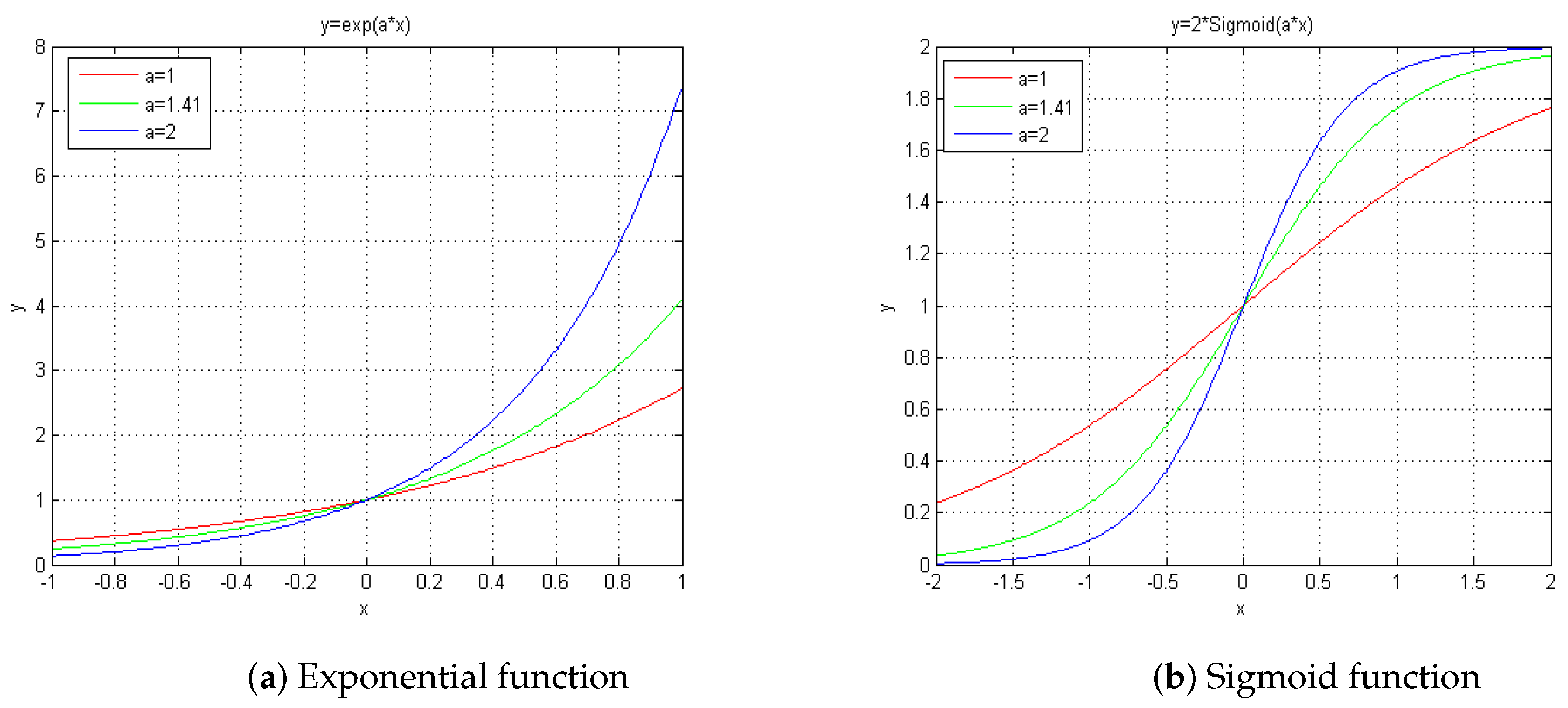

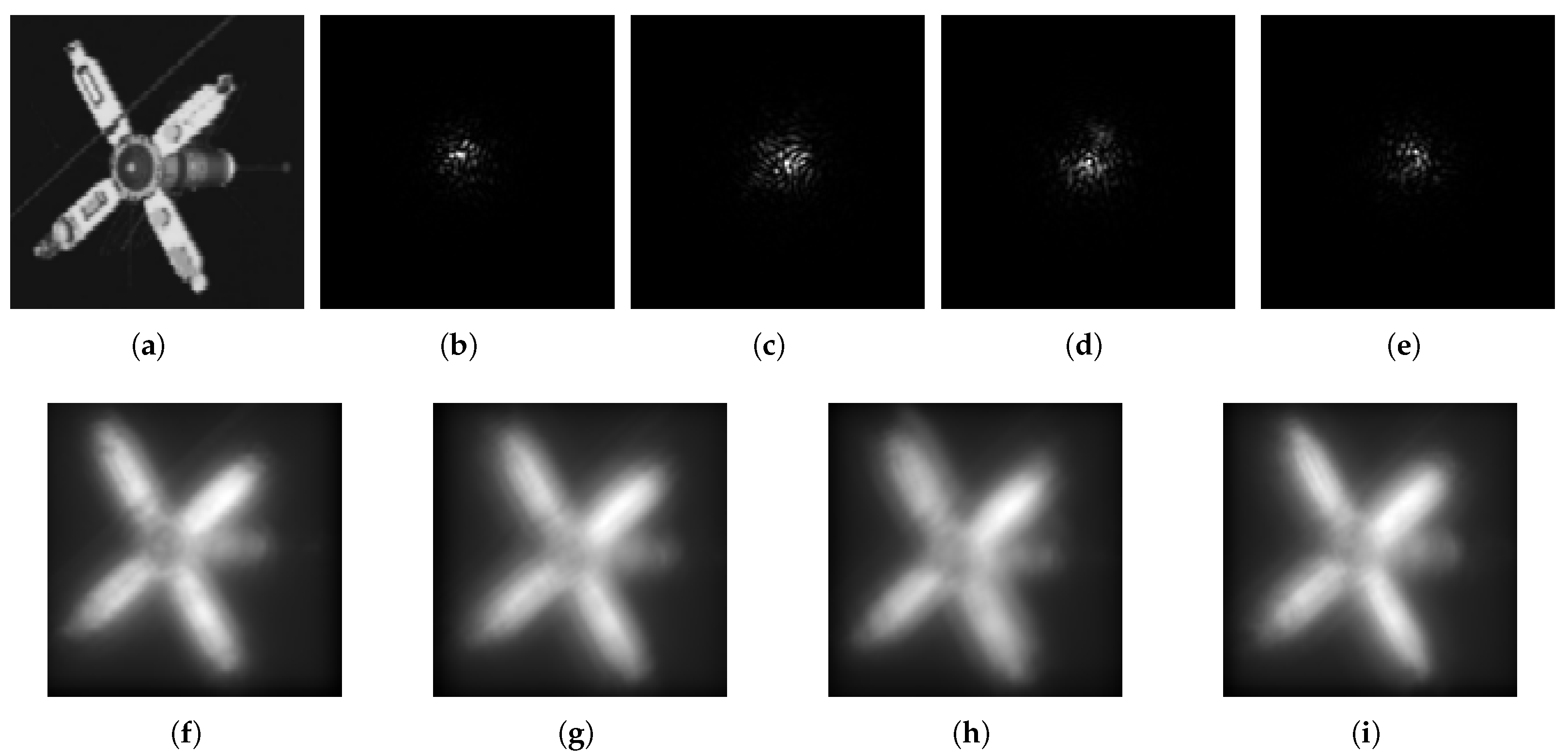

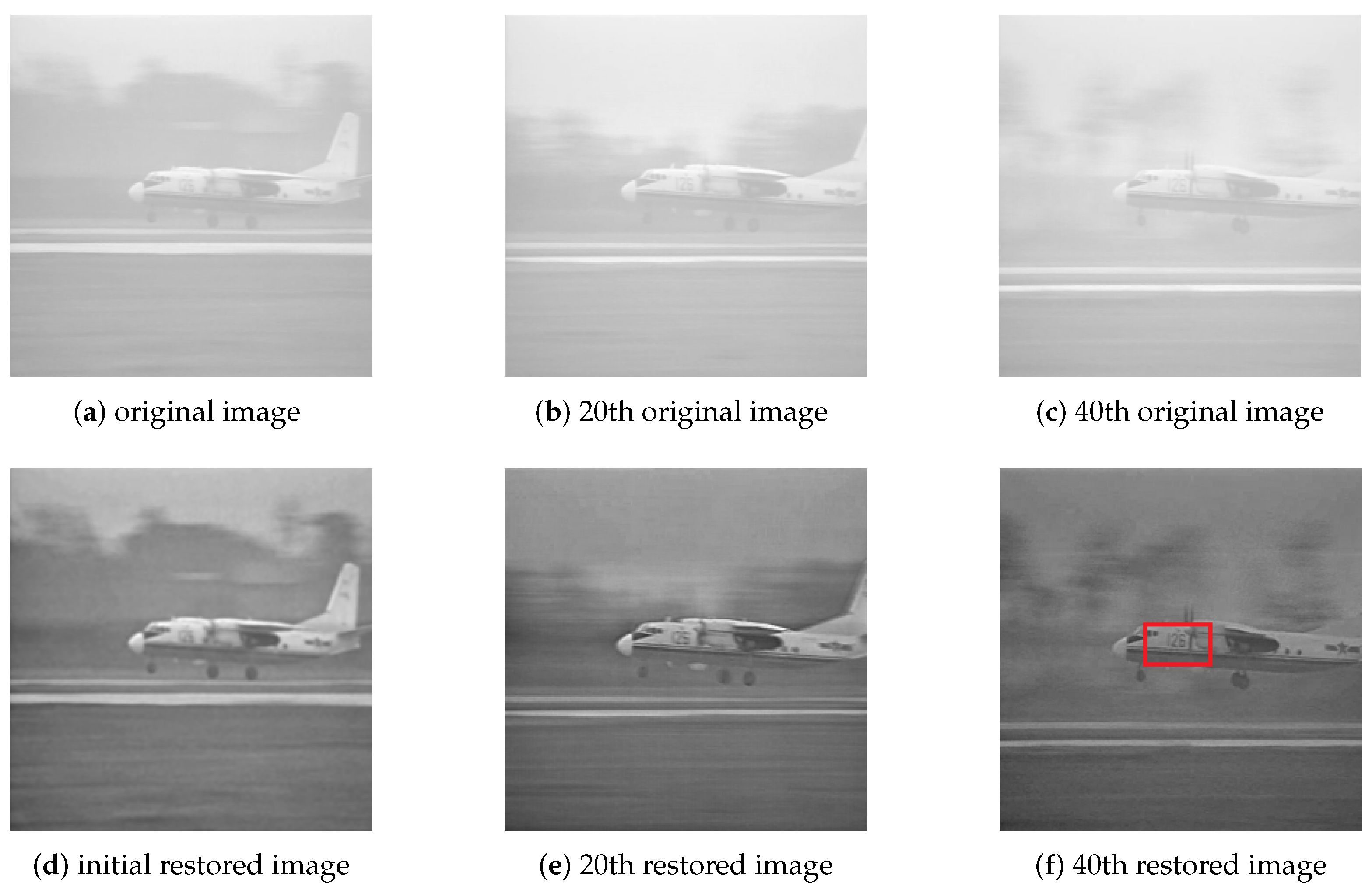


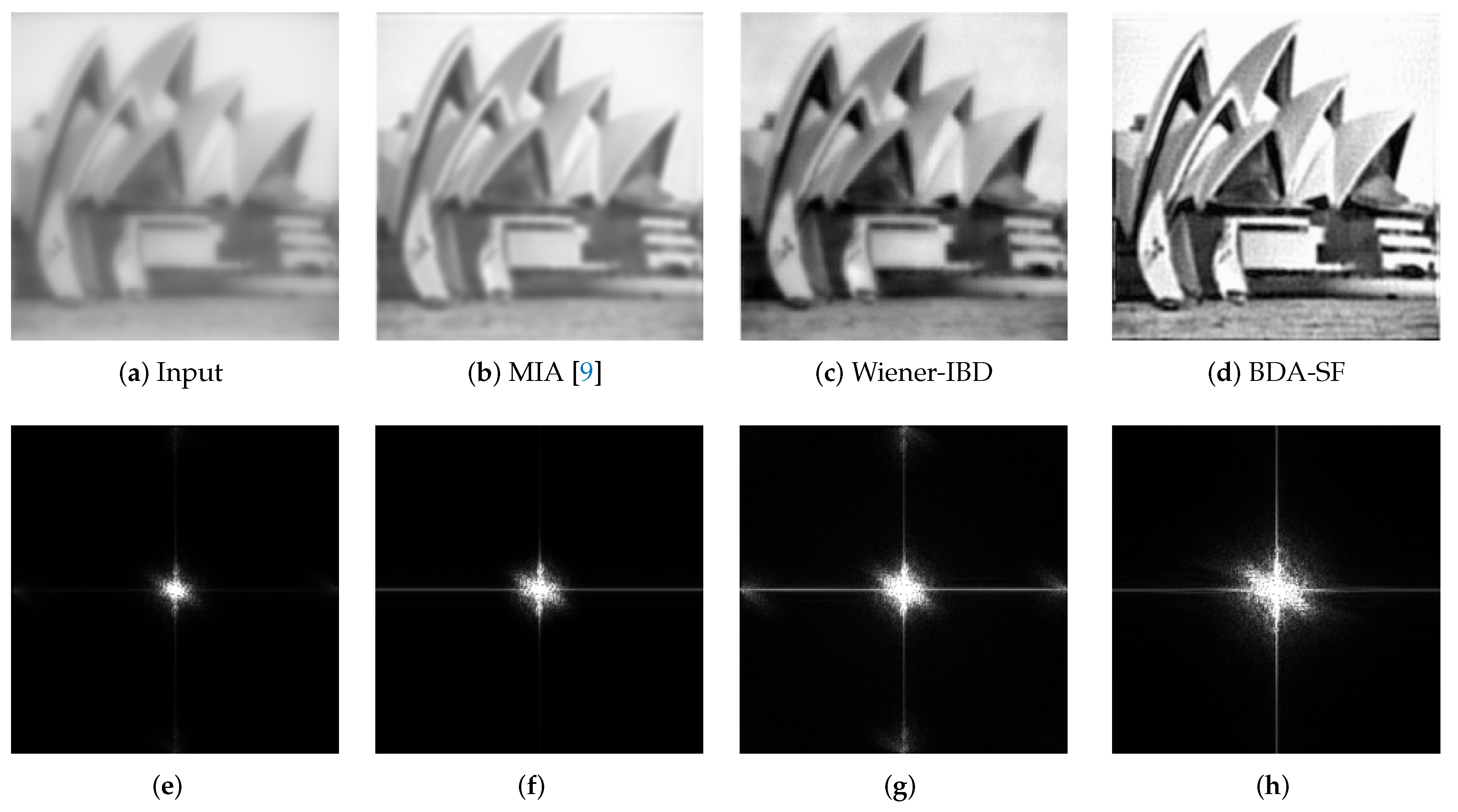


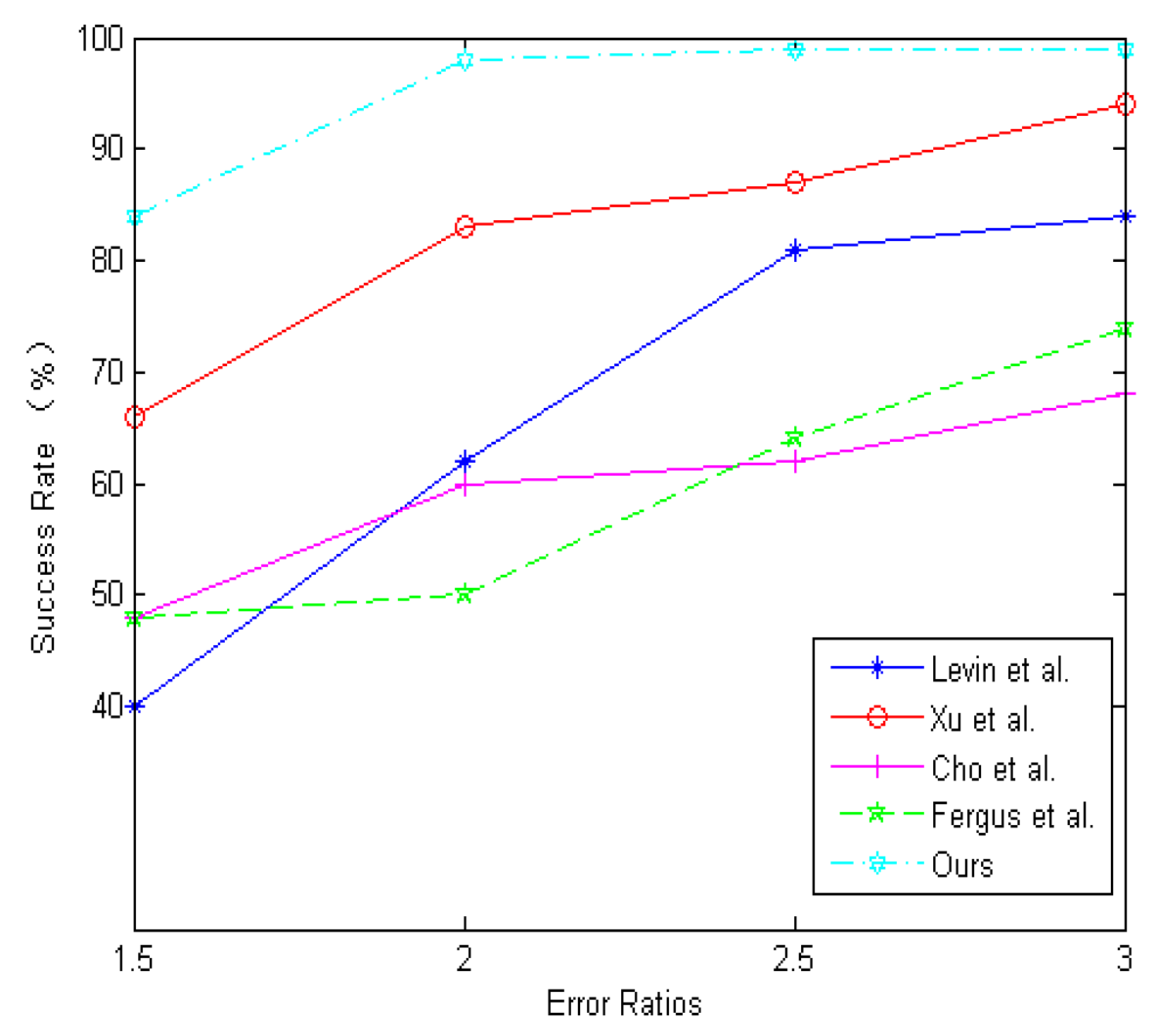

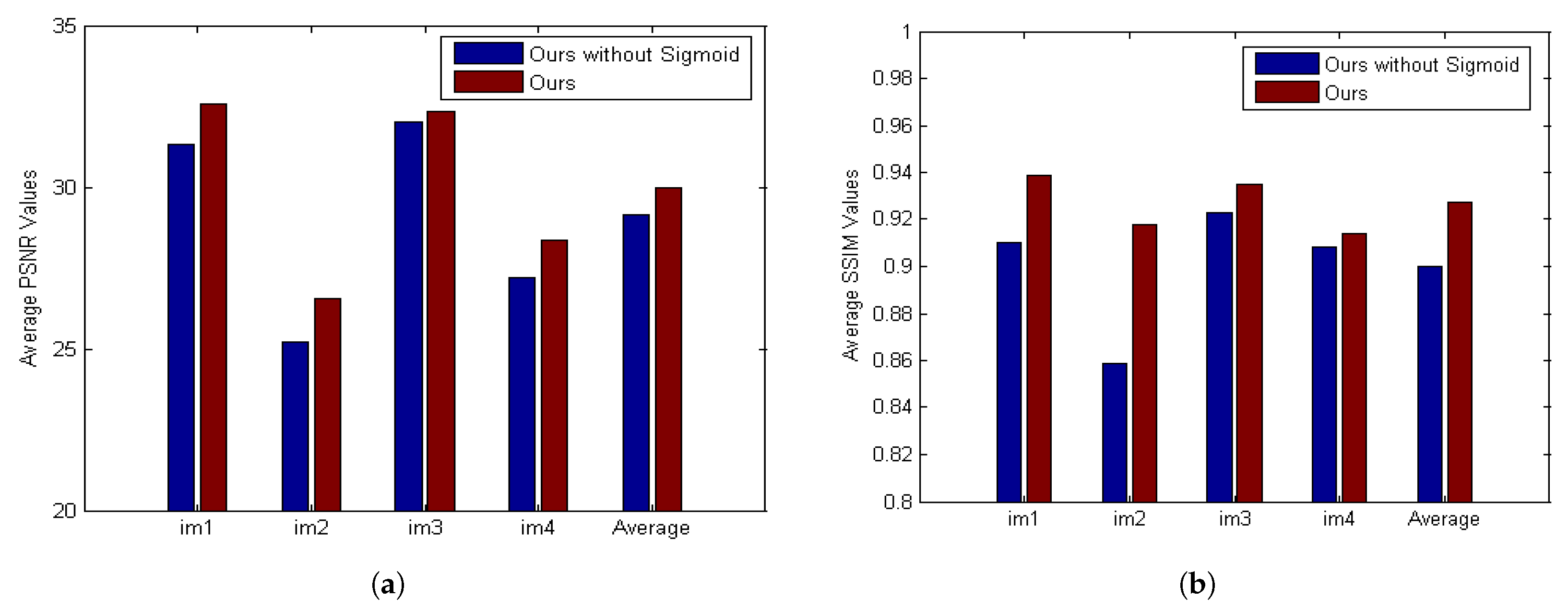

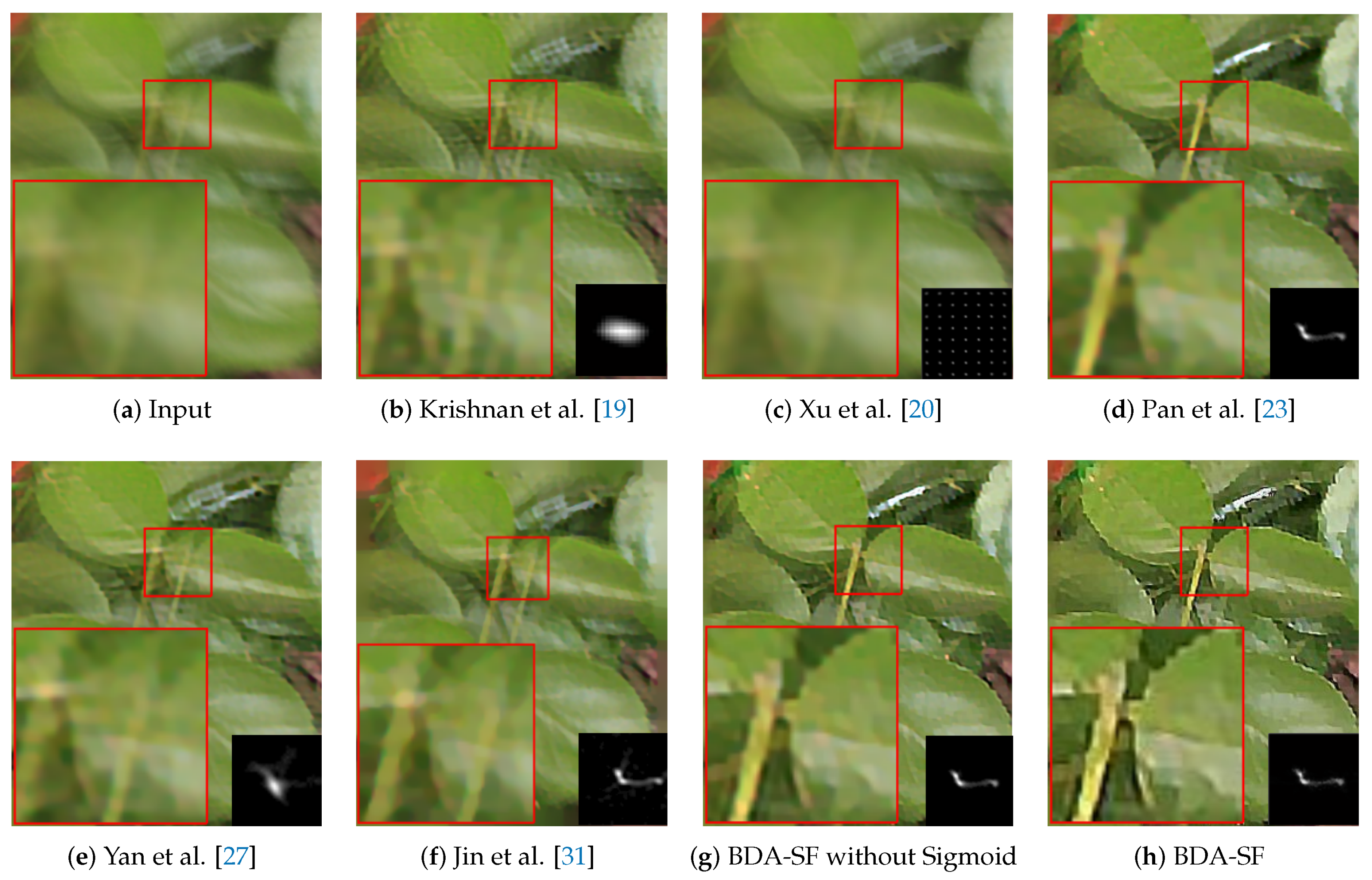
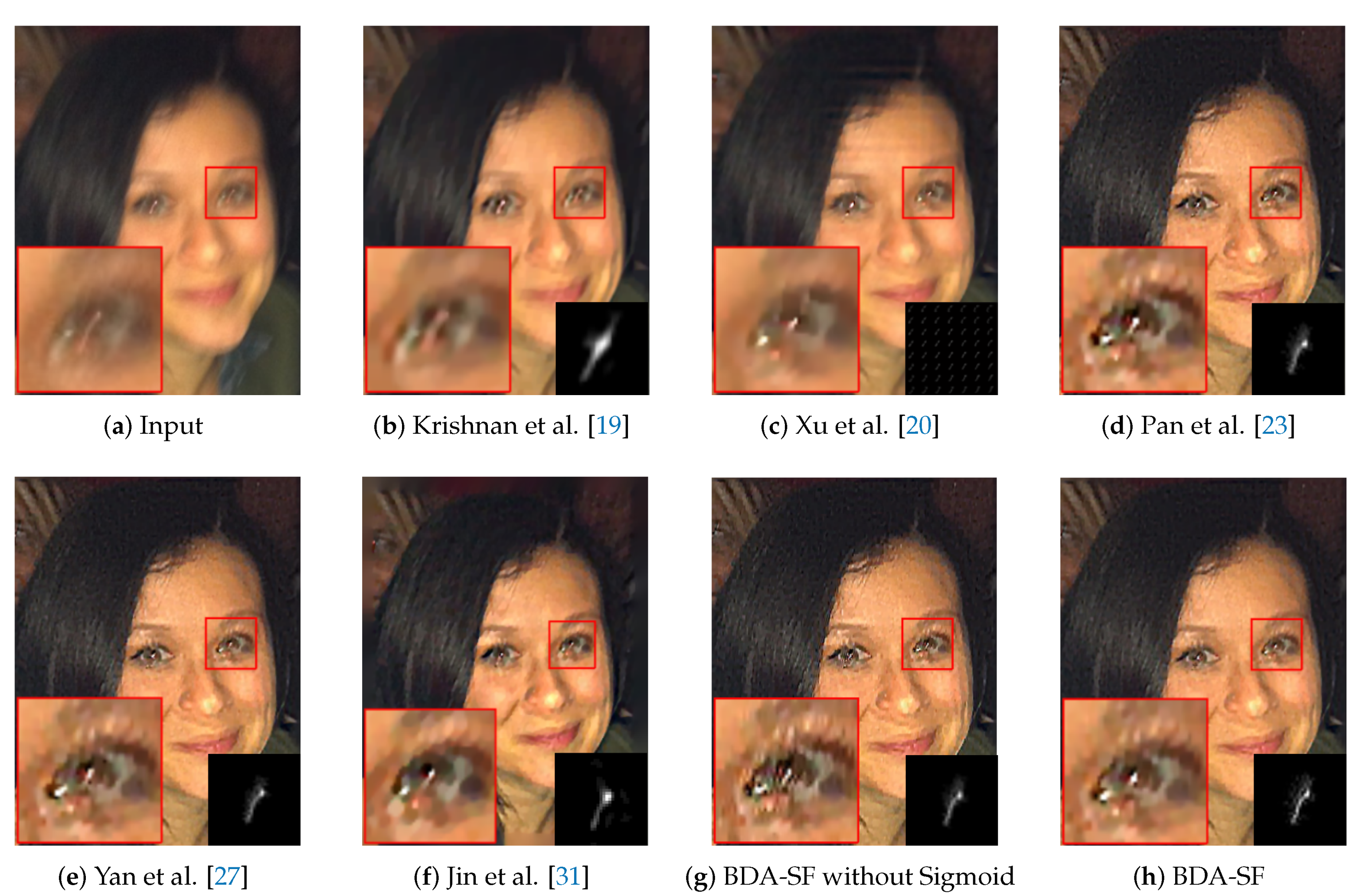

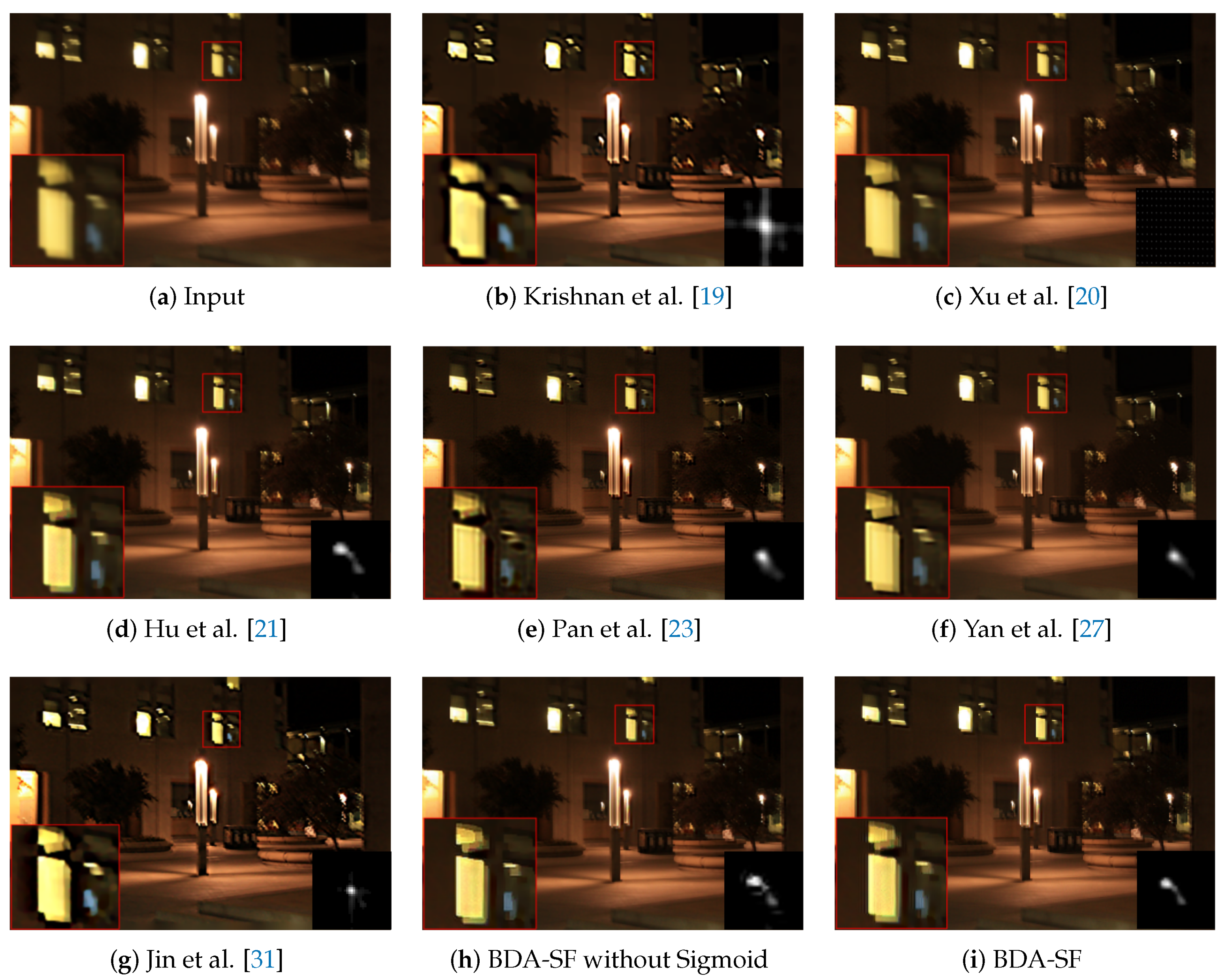
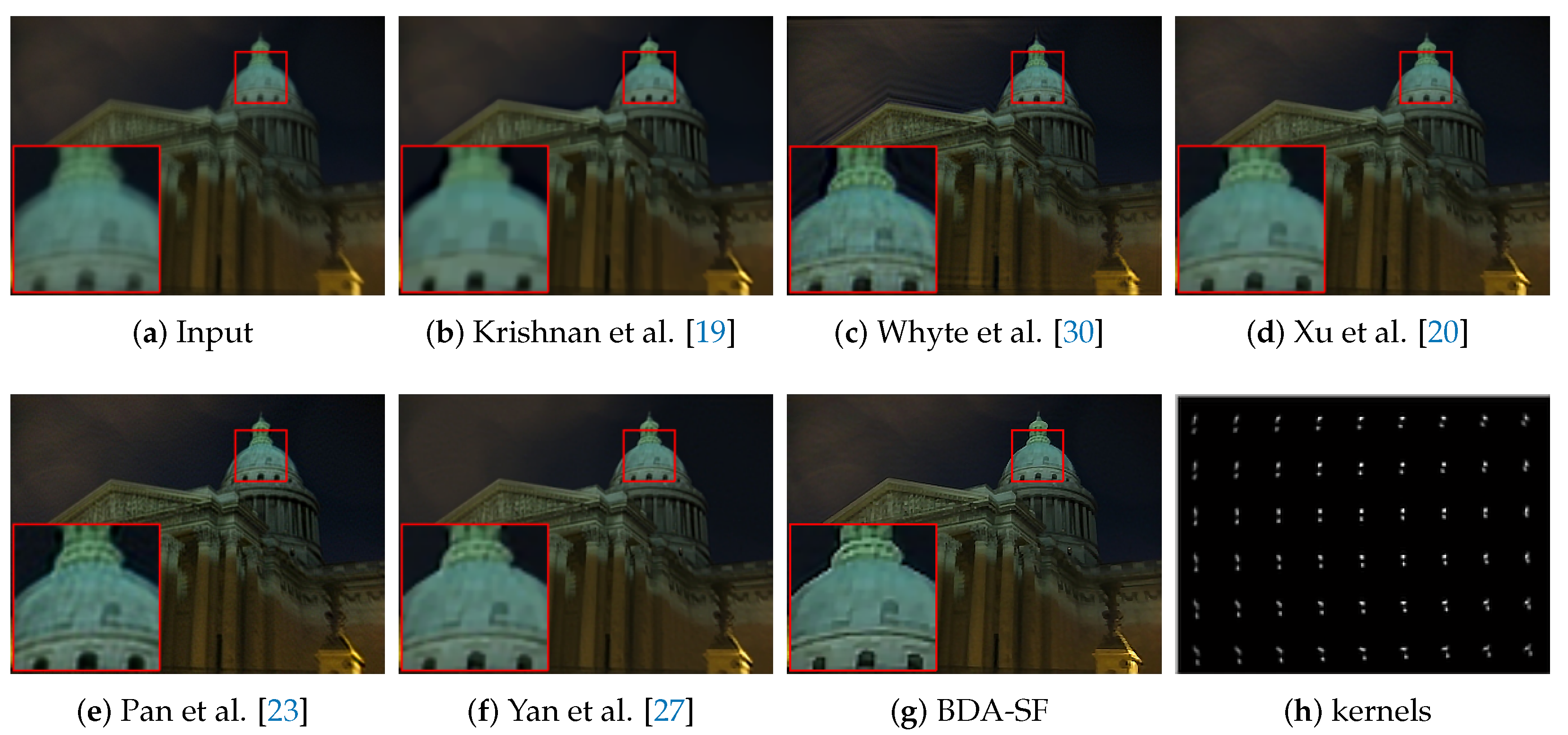
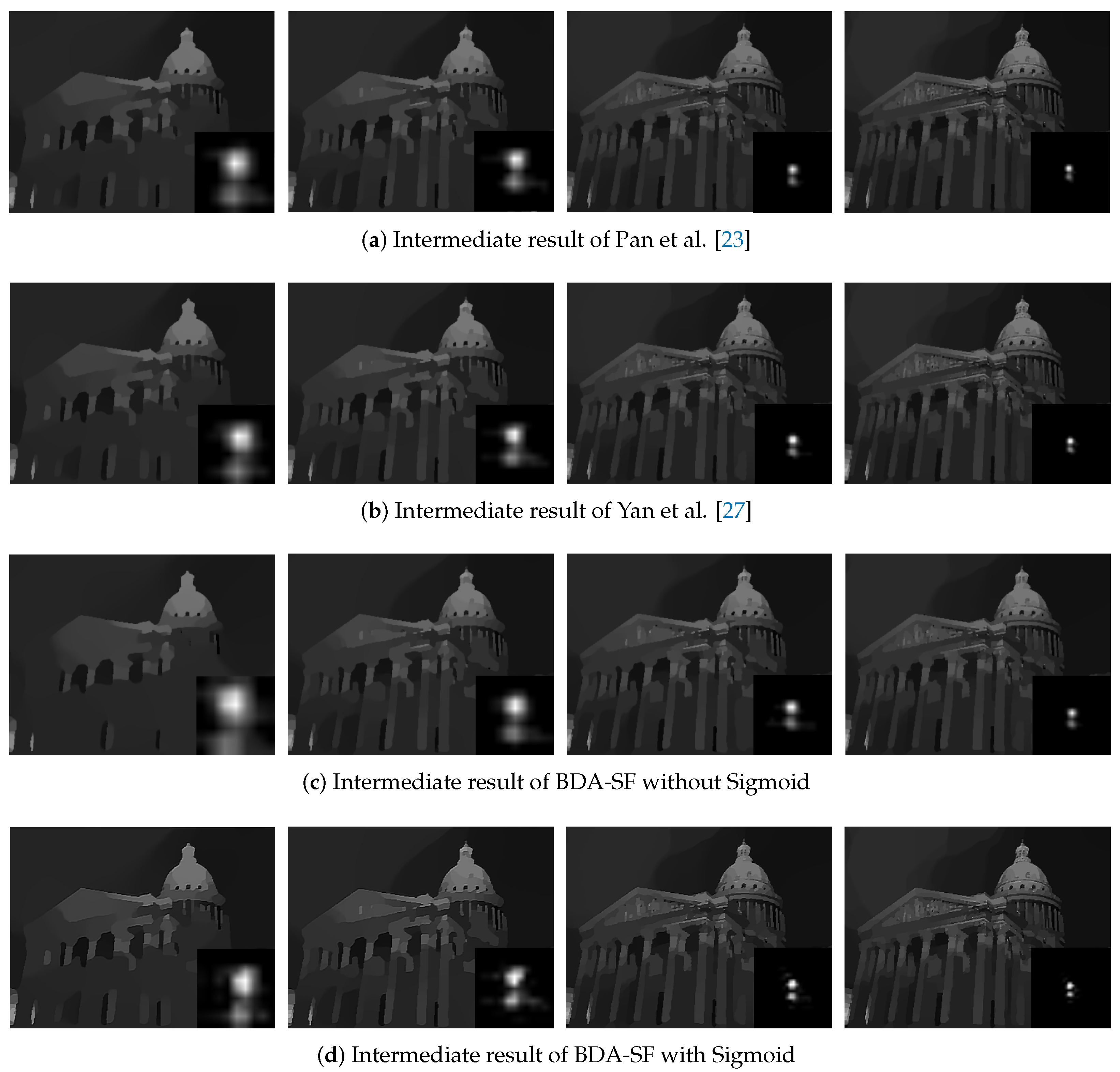
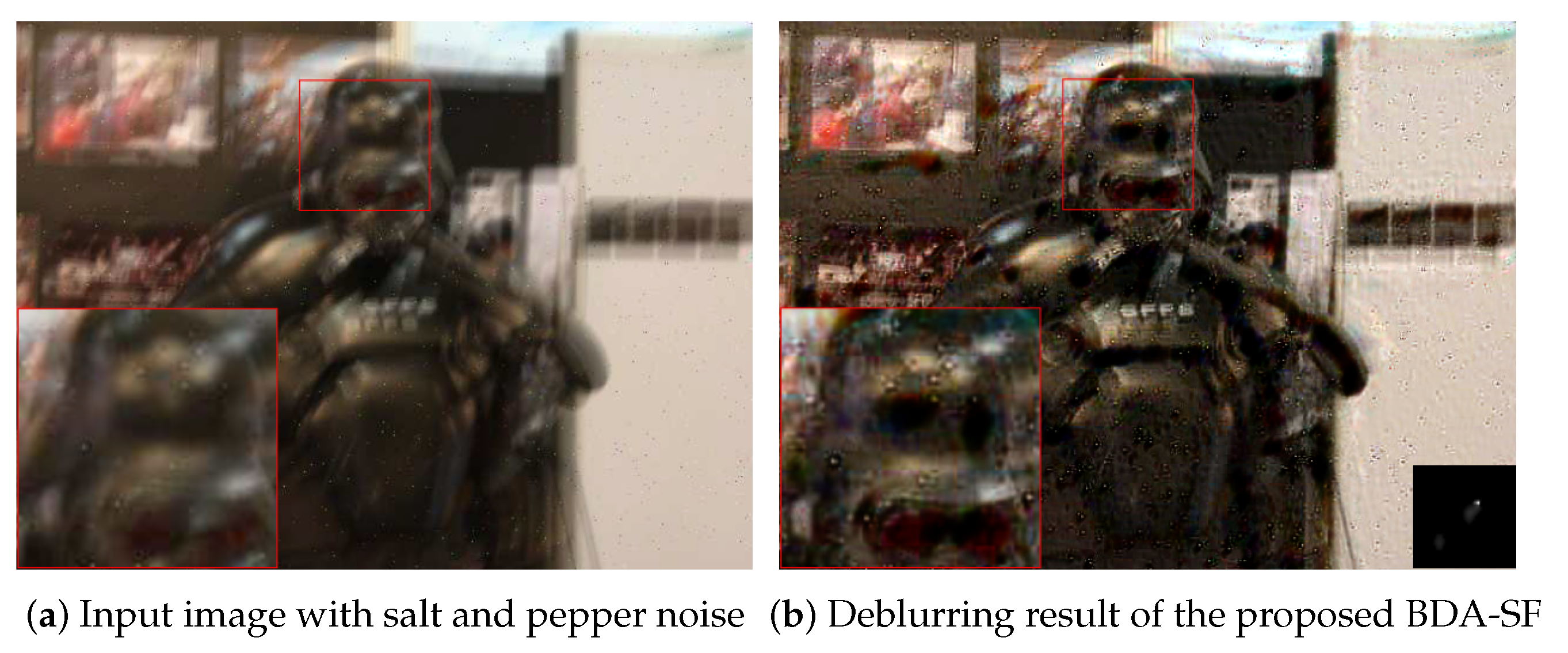
| Methods | PSNR | SSIM |
|---|---|---|
| Krishnan et al. [19] | 21.2398 | 0.7588 |
| Xu et al. [20] | 20.8402 | 0.6921 |
| Pan et al. [22] | 19.2688 | 0.6089 |
| Yan et al. [27] | 24.2150 | 0.7683 |
| Jin et al. [31] | 23.8377 | 0.7542 |
| Bai et al. [32] | 26.4120 | 0.8174 |
| BDA-SF | 27.2434 | 0.8859 |
| Methods | PSNR | SSIM |
|---|---|---|
| Xu et al. [15] | 19.0964 | 0.6987 |
| Krishnan et al. [19] | 21.9974 | 0.8330 |
| Whyte et al. [30] | 20.6246 | 0.8254 |
| Xu et al. [20] | 21.8491 | 0.8373 |
| Pan et al. [22] | 21.7723 | 0.8250 |
| Pan et al. [23] | 23.9403 | 0.8047 |
| Yan et al. [27] | 25.5430 | 0.8507 |
| Jin et al. [31] | 22.0974 | 0.8376 |
| Bai et al. [32] | 22.0311 | 0.8401 |
| BDA-SF | 25.0137 | 0.8413 |
| Methods | 280 × 325 | 284 × 365 | 1097 × 1094 | 800 × 533 |
|---|---|---|---|---|
| Krishnan et al. [19] | 20.41 | 23.71 | 156.40 | 74.37 |
| Xu et al. [20] | 226.51 | 468.56 | 4033.79 | 1655.50 |
| Pan et al. [23] | 319.34 | 295.60 | 4078.68 | 1201.16 |
| Yan et al. [27] | 47.99 | 46.50 | 1077.90 | 294.89 |
| Jin et al. [31] | 561.12 | 620.04 | 14187.65 | 2814.74 |
| BDA-SF | 255.45 | 249.95 | 3115.04 | 1075.10 |
Publisher’s Note: MDPI stays neutral with regard to jurisdictional claims in published maps and institutional affiliations. |
© 2021 by the authors. Licensee MDPI, Basel, Switzerland. This article is an open access article distributed under the terms and conditions of the Creative Commons Attribution (CC BY) license (https://creativecommons.org/licenses/by/4.0/).
Share and Cite
Sun, S.; Duan, L.; Xu, Z.; Zhang, J. Blind Deblurring Based on Sigmoid Function. Sensors 2021, 21, 3484. https://doi.org/10.3390/s21103484
Sun S, Duan L, Xu Z, Zhang J. Blind Deblurring Based on Sigmoid Function. Sensors. 2021; 21(10):3484. https://doi.org/10.3390/s21103484
Chicago/Turabian StyleSun, Shuhan, Lizhen Duan, Zhiyong Xu, and Jianlin Zhang. 2021. "Blind Deblurring Based on Sigmoid Function" Sensors 21, no. 10: 3484. https://doi.org/10.3390/s21103484
APA StyleSun, S., Duan, L., Xu, Z., & Zhang, J. (2021). Blind Deblurring Based on Sigmoid Function. Sensors, 21(10), 3484. https://doi.org/10.3390/s21103484






